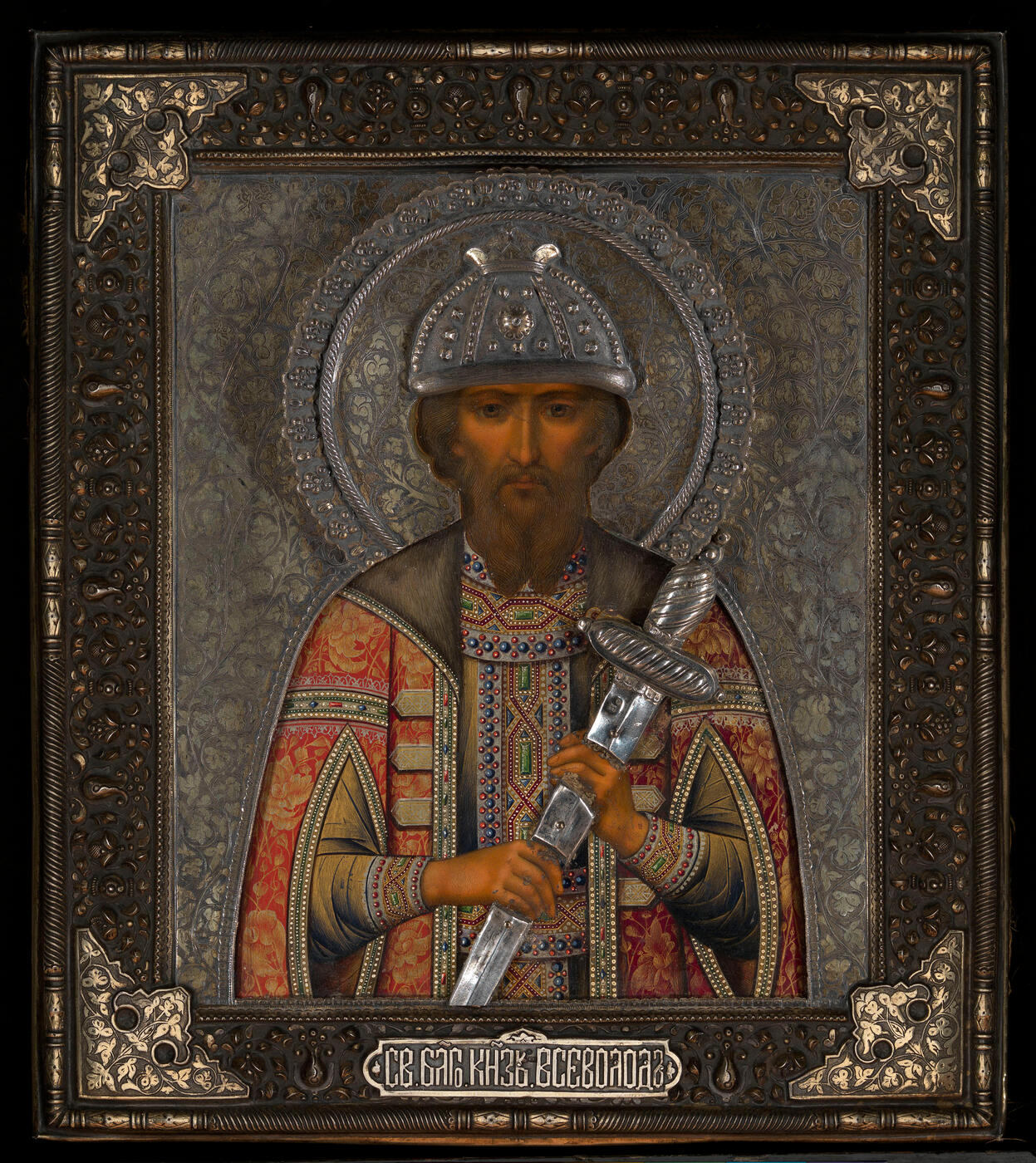5 June 2013 Russian Art Auctions
5 June 2013

613. A RARE ICON OF THE HOLY PRINCE VSEVOLOD
STAMP OF VASILY GURYANOV ON THE REVERSE, EARLY 20TH CENTURY, OKLAD STAMPED WITH MAKER'S MARK OF ANTIP KUZMICHEV IN CYRILLIC, MOSCOW, 1899-1908, 84 STANDARD.
31.5 by 27 cm.
70,000–100,000 GBP
Provenance: Acquired by the previous owner from the heirs of Vsevolod Rudnev in Paris in the 1960s.
Private collection, Europe.
Related Literature: For St Vsevolod iconography, see Pravoslavnaya entsiklopedia (Orthodox Encyclopaedia), Moscow, 2005, vol. 9, pp. 549-550.
For an example of a similar Olovyanishnikov shirt, see Religioznoe iskusstvo: sbornik rabot tserkovnoi i grazhdanskoi utvari, vypolnennoi Tovarischestvom P.I. Olovyanishnikova synovya. 1901-1911 (Religious Art: Collection of Religious and Civil Works by the P.I. Olovyanishnikov and Sons Manufactory. 1901-1911), Moscow, 1911, p. 160.
This precious commissioned image by the well-known Imperial icon painter, V.P. Guryanov, depicts Vsevolod (baptised Gavriil) Prince of Novgorod, c. 1095-1138; the eldest son of Mstislav (Feodor) and eldest grandson of Vladimir Monomakh, Prince of Kiev. Local veneration of the Prince as a saint was established by the late 12th century and his canonisation took place in 1549.
Icons depicting Prince Vsevolod are few in number – the well-known ones mainly show the saint full-length, holding the Pskov Trinity Cathedral – the church he founded and where he is buried. The only other known icon of “The Blessed Prince St. Vsevolod, baptised Gavriil, Miracle-worker of Pskov” from the turn of the 20th century, was produced in 1900 by another eminent icon-painter, M.I. Dikarev, as one of a calendar series for the chapel of the Marble Palace, St. Petersburg. This icon by Guryanov is one of the best examples of tempera painting in the late 19th and early 20th century; the face, rendered in a laboriously detailed hatching technique and the rich finish to the shirt, cloak and princely cap are all evidence that the icon was commissioned for a wealthy patron or as a valuable commemorative gift. Furthermore, it was planned from the outset that the image should be adorned by an oklad. The object’s high value is also evident in the masterly execution of the chased silver framework and the expensive gold brocade ‘shirt’ by the Olovyanishnikov factory. A unique feature of the oklad is the separate silver plating on the sword, which not only emphasises the saint’s princely origins but also reminds the viewer of an actual relic – Prince Vsevolod’s original sword – which until 1917 was kept on the saint’s tomb at the Trinity Cathedral in Pskov.
The oklad was manufactured by A.I. Kuzmichev, the owner of a major jewellery workshop in Moscow. This master jeweller was the only one in pre-revolutionary Russia to have had official contracts with Tiffany & Co, the famous American jewellers.
Although the icon has no presentation plate, it was undoubtedly intended for a person with the same name as the saint. According to its last owner, the icon was acquired in France in the 1960s from the heirs of V.F. Rudnev, a naval hero of the Russo-Japanese War. A number of considerations support the oral evidence that the artefact belonged to Rear Admiral (1905) Vsevolod Feodorovich Rudnev (1855-1913), Captain of the illustrious cruiser Varyag, which under his command, took on her unequal fight at the Battle of Chemulpo.
The first consideration is that the name Vsevolod was relatively uncommon at the turn of the 20th century. Secondly, the depiction of the saint as a Warrior Prince, suggests the recipient’s affiliations were in the military sphere. Thirdly, the Rudnev family’s move to France may explain why the icon appeared on the western antique market. And fourthly, the presentation of this icon may have coincided with a ceremony for the heroes of the Russo-Japanese War in Moscow, 14th April, 1904. Among the events was a dinner in honour of the officers of Varyag at the English Club and a copy of the menu bears the signature of V.F. Rudnev. During the ceremonies, the Commanding Officer of Varyag may well have been presented, in accordance with tradition, with a valuable icon of his saintly Warrior Prince namesake.
Coincidentally, 2013 also marks the centenary of the Rear Admiral’s death. So, offered here at auction is not only an artefact of high artistic culture with rare iconography, but also an exceptional commemorative object in terms of its historical significance.
Notes on symbols:
* Indicates 5% Import Duty Charge applies.
Ω Indicates 20% Import Duty Charge applies.
§ Indicates Artist's Resale Right applies.
† Indicates Standard VAT scheme applies, and the rate of 20% VAT will be charged on both hammer price and premium.